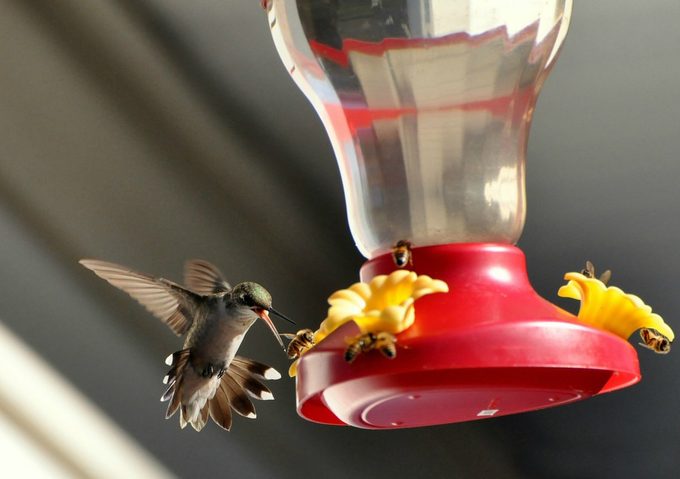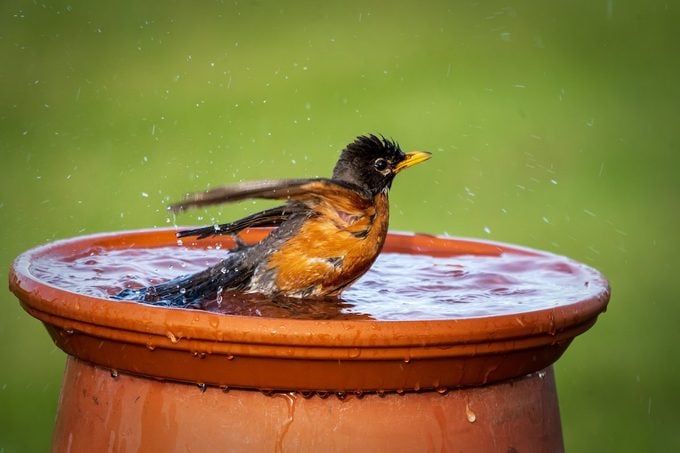75+ Solutions for Common Backyard Birdwatching Problems
Updated: Nov. 15, 2023
We’ve got answers for all your backyard birdwatching problems, including cleaning feeders and bird baths, deterring backyard pests and helping sick birds.
Chances are, the pesky bird problem you’re having in your backyard is also happening to someone halfway across the country. We’re here to help! We’ve collected some of our best solutions for the biggest and most common backyard bird watching problems. These tips have been tested and approved by both Birds & Blooms readers and our birding experts. We hope you’ll put them to good use and have your best year of birding ever!
On This Page
Feeding and Attracting Birds
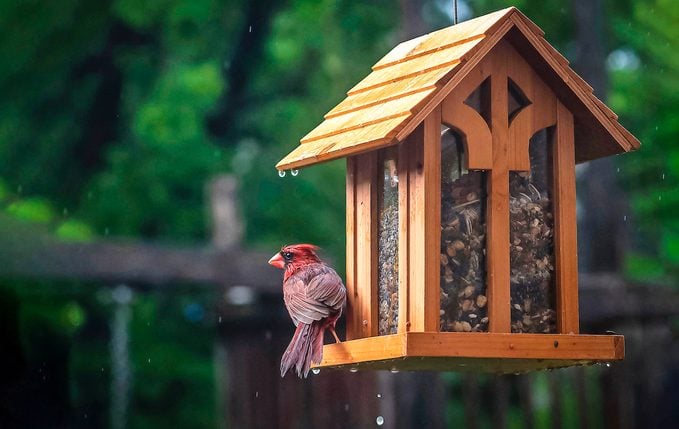
How can I protect the inside of my wooden feeder from water damage and mold?
- Apply caulk to the corners and cracks where moisture is entering.
- Put a protective covering, such as an old lampshade, umbrella or charcoal grill cover over your feeder to protect it from the elements.
- Clean it and then spray it with an outdoor sealer that’s safe for birds. If you need a recommendation, ask your local birding store experts.
Check out proven bird feeding tips to keep birdseed fresh.
How can I attract feathered friends in fall without dealing with messy suet?
- Spread lard on the bark of trees. It’s less expensive than suet and simple to serve.
- Keep the center cardboard tubes from toilet paper and paper towel rolls. Fill with suet, cover one end with duct tape and then freeze. It’s the perfect size to fill suet logs. Peel off the cardboard and fill the holes.
- Mix crunchy peanut butter, oatmeal and cornmeal together and spread it on tree trunks.
Check out 7 common questions about feeding suet to birds.
Are nuts okay to give birds? Which ones are safe?
- Peanuts are a popular choice for the backyard. Offer them in a tray feeder or a wire peanut feeder.
- Most birds will ignore non-native nuts like cashews and almonds.
- If you have leftover nuts, such as walnuts and pecans from the holidays, crack them and leave them at your feeder. It’ll keep the birds fed, possible attracting birds you wouldn’t expect.
The birds in my backyard are messy! How can I prevent the birdseed from falling all over the ground?
- Birds are less likely to spill birdseed if it is presented to them in a feeder with sides, like a tray feeder.
- Attach plastic hanging planters to the bottoms of tube feeders with metal hooks and twine. Drill holes in the planter bottoms and cover them with screens so water can drain out.
- Drill a large hole the size of the feeder pole through the center of a pizza pan and slide the pan onto the pole.
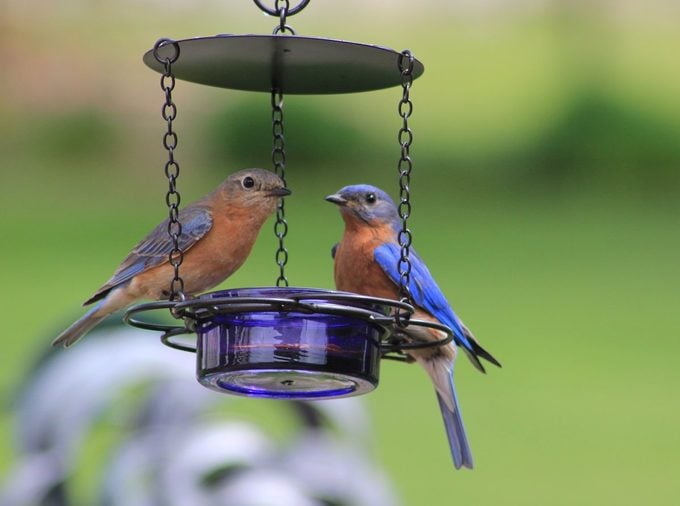
Where can I buy mealworms?
- Check your local bait shop or pet store. They likely sell them by the hundreds, and they work perfectly for backyard birding, too.
- Buy them online. Search for “mealworms,” and many retailers will pop up.
- If you want to save money and you’re ambitious, raise your own. Look online for tips on starting your own mealworm supply.
Check out our guide to feeding mealworms to birds.
How can I attract birds to my backyard in winter and offer them protection?
- Attach branches trimmed from cedar trees to your feeders. This simple addition provides birds with protective cover, which is great for attracting birds to feeders.
- Leave roosting boxes and nesting ledges up year-round.
- Change your feeder location. Don’t get in a rut. As long as the new area has protection, try new locations and you just might get new visitors.
Check out the 10 top tips for feeding birds in winter.
Feeding and Attracting Hummingbirds
How can I keep bees and ants off my hummingbird feeders?
- The best way to keep bees and ants away is by hanging a small ant guard above your feeder. This cuplike device is filled with water, creating a moat ants won’t cross.
- Place double-sided tape around the wire from which the hummingbird feeder hangs. The tape isn’t sticky enough to bother birds, bit it does deter ants. You might have to replace it as it loses its stickiness.
Check out natural ways to keep bees and ants away from hummingbird feeders.
How can I keep my hummingbird nectar from going bad in hot weather?
- For most, hanging the sugar-water feeder in the shade does the trick, but high desert temperatures can be a problem even in shady areas. Use the kind of ice pack that fits over a wine bottle, but paint it red first.
- To provide shade, attach a red plastic plate to the top of the feeder. Poke a hole in the plate that’s the same diameter as the wire from which the feeder hangs, then thread the wire through so the plate covers the feeder horizontally.
- The smartest solution is to keep it fresh. This means changing the nectar ever few days, but that’s the best for those flying jewels.
Check out hummingbird feeders your birds will love.
What’s the easiest way to clean those hard-to-reach areas of a sugar-water feeder?
- Use waterproof glue to attach a piece of foam to a long wooden dowel. Use soapy water and scrub away.
- Use an old mascara brush. Wash the bristles thoroughly and let them dry.
- Save an old toothbrush. It’s perfect for reaching small feeding ports.
Get more tips on how to clean hummingbird feeders.
How do I attract hummingbirds to my feeders?
- Hang red flowers, ribbons or even a red hand towel nearby to help hummingbirds find your feeder faster.
- Place a hanging basket of impatiens near the feeder. It provides the hummingbirds with a double treat.
- Make sure you keep your feeders filled during spring and fall migration. And don’t give up. It might take a little while for hummingbirds to establish new feeding areas.
Check out 13 questions about hummingbird feeders answered by experts.
Deterring Backyard Birding Pests
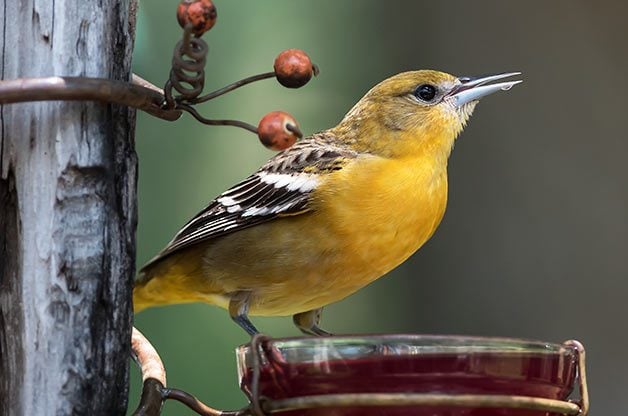
How do I keep flies out of the jelly I put out for orioles?
- Switch to sugar water to attract and keep orioles throughout the summer and into September. It’s easier to maintain and will attract fewer bees and flies.
- Keep oriole feeders out of direct sunlight.
- Hang a wasp trap next to the feeder. Bait it with the same food the birds are eating.
I’ve had it with squirrels stealing my birds’ food! How do I keep squirrels away from my feeders?
- You can’t beat a good squirrel-proof feeder or baffle. Spend a little extra to get a good one; it’s worth it!
- Give squirrels a feeding area of their own. This often will steer them away from bird feeders.
- Squirrels love sunflower seeds, so feed the birds other seeds, such as safflower and nyjer.
Check out the best squirrel-proof bird feeders and 12 tips that work.
How can I deter bears and raccoons from invading my feeders?
- Hang the bird feeders high above the reach of bears. Birds can fly to the feeders, but the bears will have to reach for them.
- Rig your feeders to a wire or pulley system. This keeps them accessible for refilling, but out of the reach of hungry bears.
- Stop feeding for a while. This will help break the bears’ habit. This works well for deterring raccoons, too.
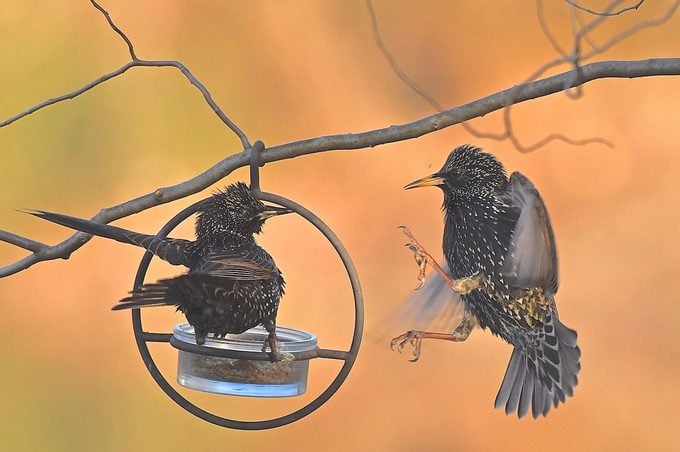
How do I deter bully birds from taking over my yard?
- Add more natural cover, especially around feeding areas. This will give smaller birds a protected safe place where they can escape if they’re attacked by birds such as crows and red-tailed hawks.
- Offer safflower seed. Crows, European starlings and pigeons generally won’t eat it, but most small songbirds will.
- Build or buy a feeder surrounded by wire mesh (1-1/2- to 2-inch holes) that’s too small for the larger bully birds to enter.
Get more advice on how to deal with bully birds at your feeders.
Woodpeckers are drilling holes in the side of my house. How can I discourage the pecking?
- Cover the area with netting or wire.
- Try to cover the holes with new siding or hardware cloth.
- Mount a plastic woodpecker decoy near the woodpecker’s favorite spot. It will fool the noisy intruder into thinking it arrived too late to protect its territory.
Learn how to tell the difference between downy and hairy woodpeckers.
Choosing and Maintaining Birdbaths
Why don’t the birds use my birdbath?
- If the bath is a bright color, it’s possible the birds can’t see the water. Paint it a buff color, but make sure the paint is waterproof and nontoxic.
- Water in birdbaths should be no more than 2 inches deep. If yours is deeper, place a large stone in the center for the birds to stand on.
- Move the birdbath away from food sources and closer to natural cover, such as a shrub or small tree.
Get more tips on how to attract birds to use a birdbath.
The summer sun heats up the water in my birdbath. Is it bad for the birds?
- Putting the bath in the shade will help, but birds are not harmed by drinking or bathing in warm water. They know enough not to drink or bathe in water that is too hot.
- Fill a container with water and freeze overnight. In the morning, place it in the middle of the birdbath to keep the water cool much longer.
- Fill it more frequently! Sure, it’s more work, but it’s definitely worth the effort when attracting birds during the summer.
Learn how to repair a cracked birdbath.
How can I prevent the water in my birdbath from freezing in winter?
- Use a shallow heated dog dish for a thrifty solution. If the water is deeper than a couple of inches, place stones inside the dish so the birds can stand.
- Set an ordinary birdbath right outside a window. Just open the window and refill. No need to go outside!
- If you can splurge a little, the best solution is a heated birdbath. Your backyard birding activity is guaranteed to increase in winter with one of these!
My birdbath is dirty. How can I clean it without harming the birds?
- Remove algae completely by using a high-pressured hose or bleach.
- Throw a few pennies into the birdbath. This may slow down the buildup of algae.
- Paint several coats of clear exterior polyurethane inside the basin. Then you can simply wipe away the grime with a rag.
Get more tips on how to clean a birdbath.
Bird Houses and Nesting Birds
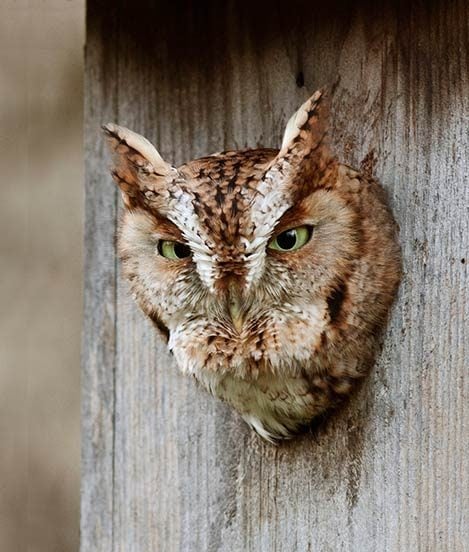
Will owls nest in nest boxes? How can I attract them to my backyard?
- Screech-owls will nest in bird houses and some will even use wood duck houses.
- Mount the house 20 to 30 feet above the ground on a tree trunk and watch the entrance hole—owls sit in the entrance at sunset!
- If you don’t live in a wooded area, it’s going to be hard to attract owls. Instead, look for the chance to go owling at a bird, nature or Audubon center near you.
Learn how to spot the owl in your backyard trees.
Tree swallows and house sparrows seem to get to our bluebird houses first. How can we make sure to attract bluebirds instead?
- Try putting up more bluebird houses, so there’s enough housing for both tree swallows and bluebirds.
- Use a style of bluebird house that isn’t acceptable to tree swallows like the ones with an open top or angled bottom.
- Technically, house sparrows are non-native so they aren’t protected. Therefore, you can remove the eggs from the house.
What should I do to get my bird houses ready for the next season?
- In fall or before spring nesting, open them up and remove the debris. Thoroughly wash inside to remove any parasites.
- To make fall cleanup super-simple, buy bird houses that don’t need to be unscrewed for cleaning. You simply lift the tops and sweep.
- If the bird house is new, it’s not a bad idea to leave it outside for a couple months or even a couple seasons. Then it’ll feel more like home to birds.
Learn how to attract birds to a birdhouse.
Sick and Injured Birds
What is wrong with the cardinals that appear to be bald? And what can I do about sick birds?
- A parasite causes the loss of head feathers, exposing the dark skin underneath. This is common among cardinals, blue jays and other songbirds.
- House finches can develop something called house finch eye disease, which makes them look sick.
- Keep your birdbaths and feeders cleaned regularly with a weak bleach solution so the birds don’t spread disease to one another.
- Rake and clean up areas under feeders and remove droppings.
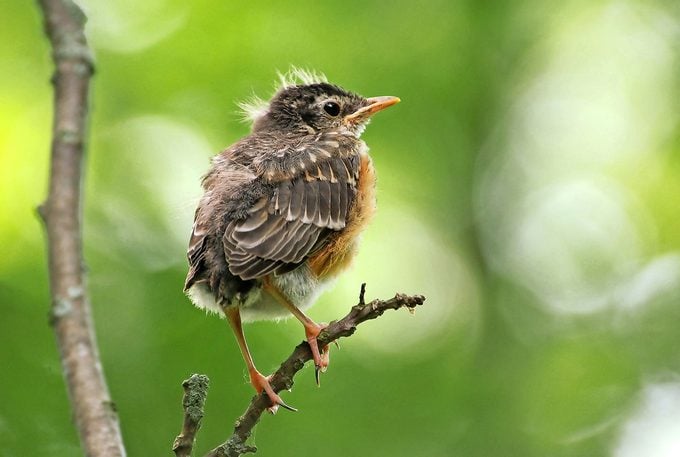
What can I do for an abandoned or injured bird?
- Place a small bird that has fallen out of its nest back into it. Birds have a poor sense of smell, so putting the nestling back in its nest is the best idea. It’s a myth that the parents will reject the baby.
- Don’t try to cage the bird. If necessary, call a local wildlife rehabilitation center.
- Leave it alone. Most of the time, the young birds aren’t really abandoned. Their parents are probably nearby.
Learn what to do if you find a bird nest with eggs or a baby bird.
How can I help a hummingbird that has accidentally flown into my garage or house?
- Place a pot of bright-red flowers in the doorway. It will be drawn to the plant and will eventually fly out.
- Paint the red pull on the garage door release white, just in case hummingbirds are attracted to the red color.
- If necessary, gently net the bird and then release it. Time is of the essence, so the quicker you can help it out, the better off it will be.
Birds are flying into my windows. How can I discourage them?
- Put clear reflective stickers on the windows.
- Keep screens on the outside of the windows, so that birds don’t see a reflection.
- Hang Christmas wrapping paper or streamers cut into long strips on the outside of windows to deter the birds, especially in spring and fall during peak migration time.
Check out more advice on how to stop window strikes at home.

